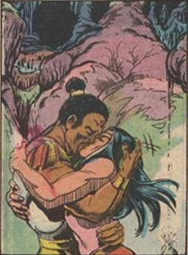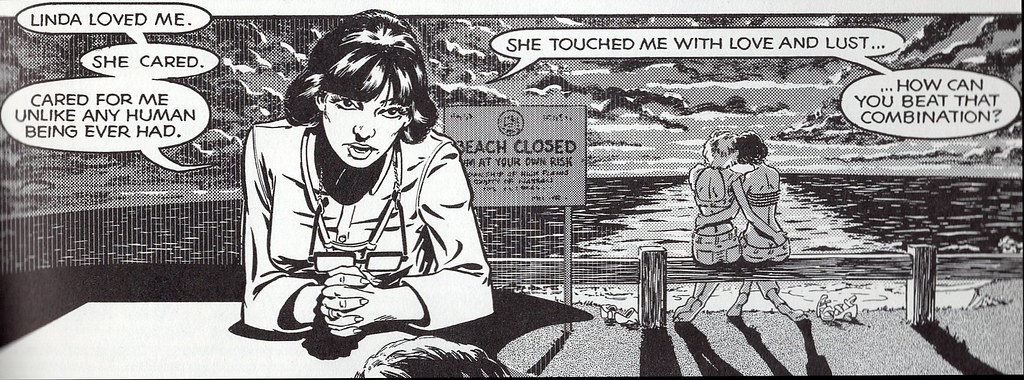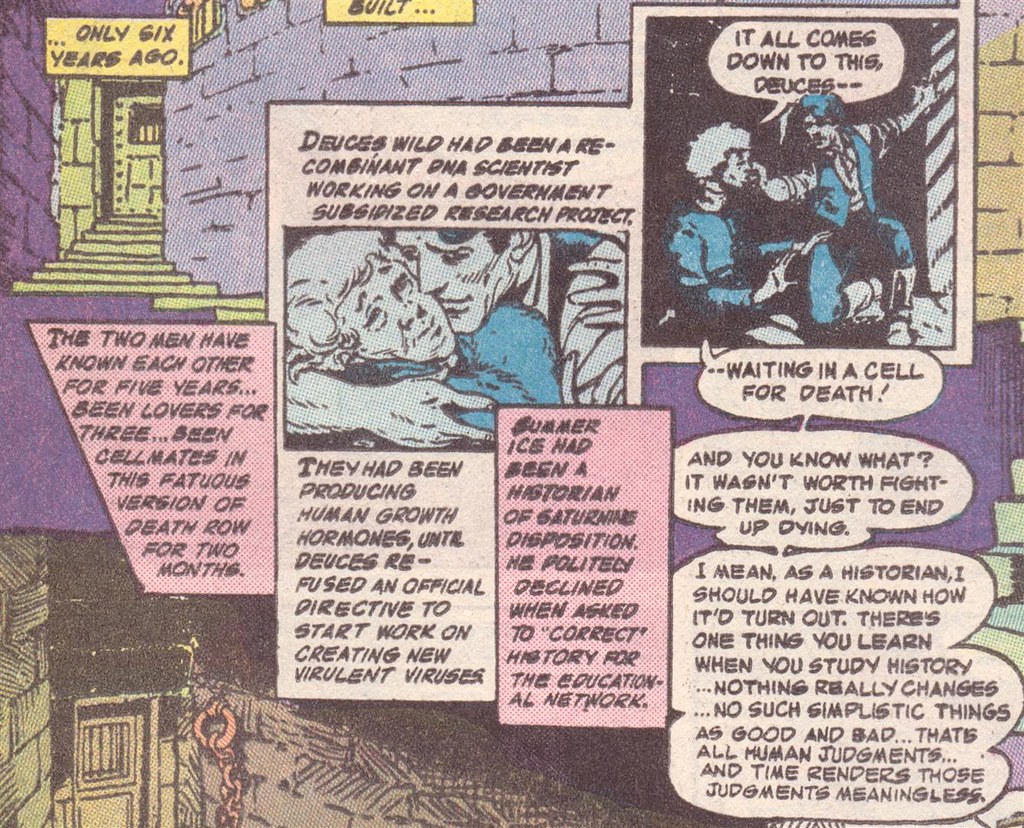 |
| Original Photo via Flickr user xlibber (CC BY 2.0) |
McGregor started out with horror and supernatural shorts appearing in Eerie, Creepy, Vampirella, and Chamber of Chills. After he established himself at Marvel, he was given the Killraven and Black Panther titles. It was during his run on Killraven with artist P. Craig Russell that McGregor wrote into existence the first romantic interracial kiss depicted in a color comic book (for an explanation on why that "first" is so heavily qualified, see this brief history of interracial romance in comic books).
 |
| Killraven #31 |
McGregor's first foray into including queer characters that I can find evidence of was 1980's Detectives, Inc.: A Remembrance of Threatening Green. The story is a couple of private investigators looking into a woman's death (Linda) on behalf of her partner, Ruth. McGregor handles discussions of sexuality fairly well here, especially considering the time. Although I can't say that Linda and Ruth's sexuality is just another part of their characters (he focuses a little too much on its importance for this to be true), he does make it clear that they have other things going on in their lives and that sexism is just a much a problem in their workplace as homophobia.
 |
| Detectives, Inc.: A Remembrance of Threatening Green |
Another reasons why Detective is such an incredible work of queer fiction, in my opinion, is this stream of thoughts that opens Chapter 4:
As they enter the maternity ward of the hospital, Rainier anticipates their first meeting with Ruth Hamilton, and the fantasies disturb him. She works in a place that has a clientele that is exclusively women, and he wonders if she can put aside her erotic persuasions and maintain the professional stance while touching all those intimate places.There's a lot negative images to be found in that paragraph, and I think it is perfectly in keeping with a character who has had no contact with the lesbian community outside of what is shown in movies and pornography. The character, Bob Rainier, even acknowledges that these are "heterosexual images of lesbians," not actual people and that he has completely dehumanized them. Rainier has these thoughts just prior to meeting his client, Ruth, with whom he develops a close friendship over the course of the rest of the book. In just 40-something pages, McGregor is able to realistically move a heterosexual man from a place of no understanding of queer people to one of acceptance and friendship. That's real talent.
He tries to obliterate the fantasies. He hasn't even met her yet, but already he sees her as Susannah York in The Killing of Sister George.
Heterosexual images of lesbians stimulate him, as he despises himself for not being able to maintain his own professional cool. Breasts flattened against breasts. Lipsticked lips on erect nipples. And then, unwanted, come the brief mini-portraits of bull-dykes, fiercely caricatured (they'll beat the shit out of you, son), and that is replaced by Dustin Hoffman's Lenny Bruce introducing Valerie Perrine's Honey Bruce to carressing another woman, and then he is lost in the outraged politics and semantics of the fanatical fringe of sisterhood.
And not once, in all the images, does he see human beings [Emphasis mine]
Two years later, in the pages of Sabre #3, McGregor and artist Billy Braham introduced what was possibly the first openly gay male couple in above ground comic books, Deuces Wild and Summer Ice.
 | ||
| Sabre #3 |
A few issues later, McGregor had yet another first kiss. This time, I believe it is the first romantic kiss between a same-sex couple. Some qualifications there because of the kiss in Action Comics #12 (a story for another time) and because a kiss seems a little less exciting after all the stuff in Detectives, Inc. Still an important milestone, I suppose.
 |
| Sabre #7 |
You're asking me about including gay characters, in this instance. There could have been some influence that, as I lived and wrote in New York, I had friends and co-workers who were gay, and so it was natural for me to want to write about the world I had around me.
The storyteller may have wanted to reflect the world around me, but I don't recall any active thought about it.
And again, I didn't understand the big deal made about it. And if, as it seemed, the bottom line for the companies was money, then why would they want to make large groups of people who buy comics non-existent?Which is, of course, the perfect answer. Queer people exist and queer people buy comics, they should therefore appear in comics. It's that simple.
Unfortunately, McGregor is not putting out much new material these days. His early work, however, exemplifies great talent and a willingness to portray characters in comic books as human beings, something that was still quite new in the 1980s. I for one will be reading it for years to come.

My opinion is that Don as a writer just makes great characters so it wouldn't matter to me if they clashed with my personal beliefs because they are first and foremost people who are wholly sketched out...and they are therefore very interesting! Wow! we are lucky to have anything by the Don!
ReplyDeletealthough not as obvious as the examples above, let's not forget Taku & Venomm from Don's Panther's Rage.
ReplyDelete